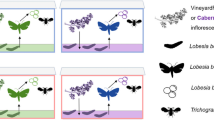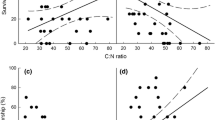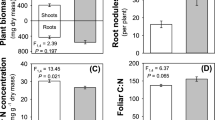Summary
Little is known about the effects of enriched CO2 environments, which are anticipated to exist in the next century, on natural plant-insect herbivore interactions. To begin to understand such effects on insect growth and survival, I reared both early and penultimate instar larvae of the buckeye, Junonia coenia (Lepidoptera: Nymphalidae), on leaves from one of their major hostplants, plantain, Plantago lanceolata (Plantaginaceae), grown in either ambient (350 PPM) or high (700 PPM) CO2 atmospheres. Despite consuming more foliage, early instar larvae experienced reduced growth on high CO2-grown compared to ambient CO2-grown leaves. However, survivorship of early instar larvae was unaffected by the CO2 treatment. Larval weight gain was positively correlated with the nitrogen concentration of the plant material and consumption was negatively correlated with foliar nitrogen concentration, whereas neither larval weight gain nor consumption were significantly correlated with foliar water or allelochemical concentrations. In contrast, penultimate instar larvae had similar growth rates on ambient and high CO2-grown leaves. Significantly higher consumption rates on high CO2-grown plants enabled penultimate instar larvae to obtain similar amounts of nitrogen in both treatments. These larvae grew at similar rates on foliage from the two CO2 treatments, despite a reduced efficiency of conversion of ingested food (ECI) on the low nitrogen, high CO2-grown plants. However, nitrogen utilization efficiencies (NUE) were unaffected by CO2 treatment. Again, for late instar larvae, consumption rates were negatively correlated with foliar nitrogen concentrations, and ECI was also very highly correlated with leaf nitrogen; foliar water or allelochemical concentrations did not affect either of these parameters. Differences in growth responses of early and late instar larvae to lower nitrogen, high-CO2 grown foliage may be due to the inability of early instar larvae to efficiently process the increased flow of food through the gut caused by additional consumption of high CO2 foliage.
Similar content being viewed by others
References
Akey DH, Kimball BA, Mauney JR (1988) Growth and development of the Pink Bollworm, Pectinophora gossypiella (Lepidoptera: Gelechiidae), on bolls of cotton grown in enriched carbon dioxide atmospheres. Envir Entomol 17:452–455
Ayres MP, MacLean SF (1987) Development of birch leaves and the growth energetics of Epirrita autumnata (Geometridae). Ecology 68:558–568
Bazzaz FA, Garbutt K (1988) The response of annuals in competitive neighborhoods: effects of elevated CO2. Ecology 69:937–946
Bazzaz FA, Chiarello NR, Coley PD, Pitelka LF (1987) Allocating resources to reproduction and defense. Bioscience 37:53–67
Berenbaum M (1985) Brementown revisited: interactions among allelochemicals in plants. Rec Adv Phytochem 19:139–169
Bernays EA (1986) Diet-induced head allometry among foliagechewing insects and its importance for graminivores. Science 231:495–497
Bernays EA, DeLuca C (1981) Insect anti-feedant properties of an iridoid glycoside: ipolamiide. Experientia 37:1289–1290
Bowers MD (1984) Iridoid glycosides and host plant specificity in larvae of the Buckeye butterfly, Junonia coenia. J Chem Ecol 10:1567–1577
Bowers MD, Puttick GM (1986) Fate of ingested iridoid glycosides in lepidopteran herbivores. J Chem Ecol 12:169–178
Bowers MD, Puttick GM (1986) The response of a generalist and a specialist insect to qualitative allelochemical variation. J Chem Ecol 14:319–334
Bremmer JM (1965) Inorganic forms of nitrogen. In: Black CA (ed) Methods of Soil Analysis. American Society of Agronomy, Madison, WI, pp 1179–1273
Butler GD, Kimball BA, Mauney JR (1986) Populations of Bemisia tabaci. (Homoptera: Aleyrodidae) on cotton grown in open-top field chambers enriched with CO2. Environ Entomol 15:61–63
Carlson RW, Bazzaz FA (1980) Elevated CO2 concentrations differentially increase growth, photosynthesis, and water use efficiency of plants — ecological implications. In: Singh JJ, Deepak A (eds) Symposium on Environmental and Climatic Impact of Coal Utilization. Academic Press, New York, pp 609–623
Cave G, Tolley LC, Strain BR (1981) Effect of carbon dioxide enrichment on chlorophyll content, starch content, and starch grain, structure in Trifolium subterraneum leaves. Phys Plant 51:171–174
Cavers PB, Bassett IJ, Crompton CW (1980) The biology of Canadian weeds. 47. Plantago lanceolata L. Can J Plant Sci 60:1269–1282
Chen CA, Drake ET (1986) Carbon dioxide increase in the atmosphere and oceans and possible effects on climate. Ann Rev Earth Plant Sci 14:201–235
Chew FS (1975) Coevolution of pierid butterflies and their cruciferous food plants. I. The relative quality of available resources. Oecologia 20:117–127
Clancy KM, Price PW (1987) Rapid herbivore growth enhances enemy attack: sublethal plant defenses remain a paradox. Ecology 68:733–737
Coley PD (1973) Herbivory and defensive characteristics of tree species in lowland tropical forests. Ecol Monogr 53:209–233
Cornell JC, Stamp NE, Bowers MD (1987) Developmental change in aggregation, defense and escape behavior of buckmoth caterpillars, Hemileuca lucina (Saturniidae). Behav Ecol Sociobiol 20:383–388
Dobkin DS, Olivieri I, Ehrlich PR (1987) Rainfall and the interaction of microclimate with larval resources in the population dynamics of checkerspot butterflies (Euphydryas editha) inhabiting serpentine grassland. Oecologia 71:161–166
Edwards PJ, Wratten SD (1985) Induced plant defences against grazing: fact or artefact? Oikos 44:70–74
El-Naggar LJ, Beal JL (1980) Iridoids: a review. J Nat Prod 43:649–707
Fajer ED, Bowers MD, Bazzaz FA (1989) The effects of enriched carbon dioxide atmospheres on plant/insect herbivore interactions. Science 243:1198–1200
Feeny P (1970) Seasonal changes in oak leaf tannins and nutrients as a cause of spring feeding by winter moth caterpillars. Ecology 51:565–581
Gallagher RN, Weldon CO, Boswell FC (1976) A semiautomated procedure for total nitrogen in plant and soil samples. Soil Sci Soc Am 40:887–889
Gardner DR, Stermitz FS (1988) Hostplant utilization and iridoid glycoside sequestration by Euphydryas anicia individuals and populations. J Chem Ecol 14:2147–2168
Gould F (1984) Mixed function oxidases: a devil's advocate position. Ecol Entomol 9:29–34
Jones RE (1977) Search behaviour: a study of three caterpillar species. Behaviour 60:237–258
Kennedy GG, Farrar RR, Riskallah MR (1987) Induced tolerance of neonate Heliothis zea to host plant allelochemicals and carbaryl following incubation of eggs on foliage of Lycopersicon hirsutum f. glabratum. Oecologia 73:615–620
Lincoln DE, Couvet D (1989) The effect of carbon supply on allocation to allelochemicals and caterpillar consumption of peppermint. Oecologia 78:112–114
Lincoln DE, Newton TS, Ehrlich PR, Williams KS (1982) Coevolution of the checkerspot butterfly Euphydryas chalcedona and its larval food plant Diplacus aurantiacus: larval response to protein and leaf resins. Oecologia 52:216–223
Lincoln DE, Sionit N, Strain BR (1984) Growth and feeding response of Pseudoplusia includens (Lepidoptera: Noctuidae) to host plants grown in controlled carbon dioxide atmospheres. Environ Entomol 13:1527–1530
Lincoln DE, Couvet D, Sionit N (1986) Response of an insect herbivore to host plants grown in enriched carbon dioxide atmospheres. Oecologia 69:566–570
Mattson WT (1980) Herbivory in relation to plant nitrogen content. Ann Rev Ecol Sys 11:119–161
May ML (1979) Insect thermoregulation. Ann Rev Entomol 24:313–349
McNeil S, Southwood R (1978) The role of nitrogen in the development of insect/plant relationships. In: Harborne J (ed) Biochemical Aspects of Plant and Animal Coevolution. Academic Press, London, pp 77–98
Mihaliak CA, Lincoln DE (1985) Growth pattern and carbon allocation to volatile leaf terpenes under nitrogen-limiting conditions in Heterotheca subaxillaris (Asteraceae). Oecologia 66:423–426
Osbrink WE, Trumble JT, Wagner RE (1987) Host suitability of Phaseolus lunata for Trichoplusia ni (Lepidoptera: Noctuidae) in controlled carbon dioxide atmosphere. Environ Entomol 16:639–644
Pereyra PC, Bowers MD (1988) Iridoid glycosides as oviposition stimulants for the buckeye, Junonia coenia (Nymphalidae). J Chem Ecol 14:917–928
Porter K (1983) Multivoltinism in Apanteles bignellii and the influence of weather on synchronization with its host, Euphydryas aurinia. Ent Exp Appl 34:155–162
Price PW, Bouton CE, Gross P, McPheron BA, Thompson JN, Weis AE (1980) Interaction among three trophic levels: influence of plants on interactions between insect herbivores and natural enemies. Ann Rev Ecol Sys 11:41–65
Puttick GM, Bowers MD (1988) The effect of qualitative and quantitative variation in allelochemicals on a generalist insect: iridoid glycosides and the southern armyworm. J Chem Ecol 14:335–351
Rosenthal GA, Janzen DH (1979) Herbivores: their interactions with secondary plant metabolites. Academic Press, New York, p 717
Schultz JC (1983) Habitat selection and foraging tactics of caterpillars in heterogeneous habitats. In: Denno RF, McClure MS (eds) Variable Plants and Herbivores in Natural and Managed Systems. Academic Press, New York, pp 61–90
Scott JA (1986) The butterflies of North America. Stanford University Press, Stanford, CA, p 583
Scriber JM (1977) Limiting effects of low leaf-water content on the nitrogen utilization, energy budget, and larval growth of Hylophora cecropia (Lepidoptera: Saturniidae). Oecologia 28:269–287
Scriber JM (1979) Effects of leaf water suplementation upon postingestive nutritional indices of forb-, shrub-, vine-, and treefeeding Lepidoptera. Ent Exp Appl 25:240–252
Scriber JM (1982) The behavior and nutritional physiology of southern armyworm larvae as a function of plant species consumed in earlier instars. Ent Exp Appl 31:359–369
Scriber JM, Slansky F (1981) The nutritional ecology of immature insects. Ann Rev Entomol 26:183–211
Slansky F, Feeny P (1977) Stabilization of the rate of nitrogen accumulation by larvae of the cabbage butterfly on wild and cultivated food plants. Ecol Monogr 47:209–228
Slansky F, Scriber JM (1985) Food consumption and utilization. Comprehensive Insect Physiology, Biochemistry, and Pharmacology, Kerkut GA, Gilbert LI (eds). Pergamon Press, Oxford, pp 87–163
Sokal RR, Rohlf FJ (1981) Biometry, 2nd Edition. Freeman, San Francisco, p 855
Stamp NE (1986) Physical constraints of defense and response to invertebrate predators by pipevine caterpillars (Battus philenor: Papilionidae). J Lep Soc 40:191–205
Strain BR, Cure JD (1985) Direct effects of increasing carbon dioxide on vegetation. US Dept Energy. Washington, DC p 286
Strong DR, Lawton JH, Southwood R (1984) Insects on Plants. Harvard University Press, Cambridge, MA, p 313
Waldbauer GP (1968) The consumption and utilization of food by insects. Rec Adv Insect Physiol 5:229–288
Williams EH (1981) Thermal influences on oviposition in the montane butterfly, Euphydryas gilletii (Nymphalidae). Oecologia 50:342–346
Williams WE, Garbutt K, Bazzaz FA, Vitousek PM (1986) The response of plants to elevated CO2: IV. Two deciduous forest-tree communities. Oecologia 69:454–459
Woodwell GM, Hobbie JE, Houghton RA, Mellilo JM, Moore B, Peterson BJ, Shaver GR (1983) Global deforestation: contribution to atmospheric carbon dioxide. Science 222:1081–1086
Wong SC (1979) Elevated atmospheric partial pressure of CO2 and plant growth. I. Interactions of nitrogen nutrition and photosynthetic capacity in C3 and C4 plants. Oecologia 44:68–74
Author information
Authors and Affiliations
Rights and permissions
About this article
Cite this article
Fajer, E.D. The effects of enriched CO2 atmospheres on plant-insect herbivore interactions: growth responses of larvae of the specialist butterfly, Junonia coenia (Lepidoptera: Nymphalidae). Oecologia 81, 514–520 (1989). https://doi.org/10.1007/BF00378962
Received:
Accepted:
Issue Date:
DOI: https://doi.org/10.1007/BF00378962




